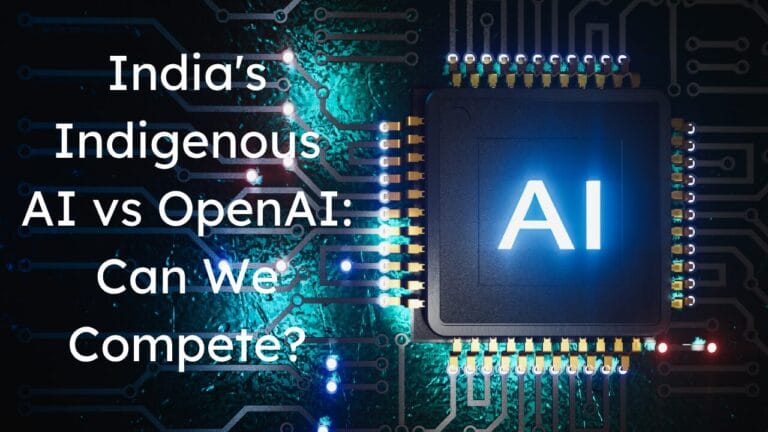
Table of Contents
1. Introduction
Artificial Intelligence (AI) is rapidly shaping the world, and giants like OpenAI and Google dominate the global space with ChatGPT and Gemini. But in 2025, India has firmly stepped into the AI race. With initiatives like Sarvam AI, BharatGPT, Krutrim AI, and the government-backed IndiaAI Mission, the dream of a homegrown AI model that speaks and understands India is becoming a reality.
But can we really compete with Silicon Valley?
Let’s explore India indigenous AI model and whether it can stand toe-to-toe with the likes of OpenAI.
2. What Is Indigenous AI?
Indigenous AI refers to artificial intelligence models developed within a country using local data, talent, languages, and infrastructure, instead of depending on foreign technologies.
For India, this means building LLMs (Large Language Models) that:
Understand Indian languages
Respect Indian cultural nuances
Are stored and trained on Indian soil
3. Why Is India Building Its Own AI?
There are four core reasons behind this push:
a) Digital Sovereignty
India wants to reduce dependency on foreign tech companies for critical digital infrastructure, especially for AI.
b) Language Inclusivity
OpenAI and Google models are primarily trained in English and a few global languages, while India has 22 official languages and hundreds of dialects.
c) Cost Efficiency
Accessing global AI APIs (like ChatGPT or Gemini) can be expensive. Indian models will offer affordable or free access to startups, educators, and citizens.
d) Data Privacy & Control
With AI handling sensitive user data, it’s vital that this data resides within Indian jurisdiction under Indian laws.
4. Key Players in India’s AI Race
Here are the top Indian organizations developing indigenous AI models:
Sarvam AI
Founded by former Microsoft researchers
Focused on voice and text AI in Indian languages
Trained on Indian data corpus
Krutrim AI (by Ola’s Bhavish Aggarwal)
India’s first unicorn in AI
Working on multilingual LLMs
Emphasizes complete AI stack ownership (from chips to cloud)
BharatGPT (by IIT Bombay, Seetha Mahalaxmi Healthcare)
Aims to build AI for healthcare, agriculture, and governance
Collaborative project involving AI4Bharat, IITs, and startups
IndiaAI Mission (Govt. of India)
₹10,000 crore+ funding announced
Aims to build India-specific foundational models
Supports GPU clusters, compute power, and open datasets
5. Challenges in Competing with Global Giants
India is just getting started, and we must acknowledge the hurdles:
1. Compute Power & Infrastructure
Training models like GPT-4 requires tens of thousands of GPUs and massive energy costs. India currently lacks this scale.
2. Skilled AI Talent
While India has top engineers, many migrate abroad due to better funding and resources.
3. Training Data for Indian Languages
Creating clean, large-scale datasets in Tamil, Bengali, Bhojpuri, Urdu, etc., is tough due to lack of digitized content.
4. Funding Gaps
Compared to billions poured into OpenAI and Google DeepMind, Indian AI startups are still bootstrapping or relying on limited VC funding.
6. Indian Language AI: A Unique Advantage
Here’s where India shines.
Global LLMs are weak in non-English conversations, but Indian startups are prioritizing vernacular content. This makes indigenous AI extremely useful for:
Voice assistants for farmers in Hindi or Marathi
Chatbots for rural health workers
AI tutors for children in Telugu or Malayalam
By solving for India first, we might actually build models that serve the Global South, not just English-speaking elite users.
7. How Far Are We From ChatGPT-Level Models?
Let’s be honest — ChatGPT-4 and Gemini 1.5 Pro are still far ahead in terms of:
Reasoning ability
Code generation
Multimodal AI (images + text + audio)
However, India is making rapid progress with smaller, fine-tuned models that serve specific domains like health, education, and legal support.
Think of it like this:
OpenAI builds a supercomputer brain for the world.
India is building regional experts who speak the people’s language.
8. Government’s Role: The IndiaAI Mission
In March 2024, the Indian government announced the IndiaAI Mission, allocating ₹10,371 crore to boost indigenous AI.
Key pillars:
National Data Management Office to streamline open datasets
IndiaAI Compute Platform for affordable access to GPU clusters
AI Foundational Model trained on Indian data
Support for AI research institutions and startups
This makes India one of the few countries globally to fund sovereign AI at this scale.
9. Future of Indigenous AI in India
With the right mix of policy support, private innovation, and public interest, India could become a global leader in inclusive AI.
Possible future outcomes:
AI doctors speaking regional languages
AI-powered governance tools for panchayats
Indian LLMs exported to other multilingual nations (Africa, SEA)
Rather than compete head-on with Silicon Valley, India could carve a new model for ethical, regional, and accessible AI.
10. Final Thoughts
India’s push toward indigenous AI isn’t about rivalry—it’s about relevance. While we may not beat OpenAI at GPT-5 scale, we can certainly build the AI that India needs most.
And maybe, just maybe, the rest of the world might learn from how we build AI for 1.4 billion people in 1000+ dialects.
The future is not just artificial—it’s authentically Indian.
Frequently Asked Questions (FAQs)
Q1. What is an indigenous AI model?
An indigenous AI model is one that is developed using local data, languages, and infrastructure, often tailored to the unique needs of the region or country.
Q2. Who are the top players in India’s AI development?
Some major players include:
Sarvam AI
Krutrim AI
BharatGPT
Government’s IndiaAI Mission
Q3. Why doesn’t India use ChatGPT or Gemini instead?
While global tools are useful, they don’t serve Indian languages or cultural context well. They’re also expensive and less customizable for local use.
Q4. Will India ever match the scale of OpenAI?
In terms of raw scale and compute, it may take years. But in regional AI applications, India can lead globally due to its linguistic diversity and grassroots demand.
Q5. How can I try or contribute to Indian AI tools?
Check out:
You can contribute by:
Creating or translating datasets
Using open-source Indian AI tools
Supporting Indian AI startups
